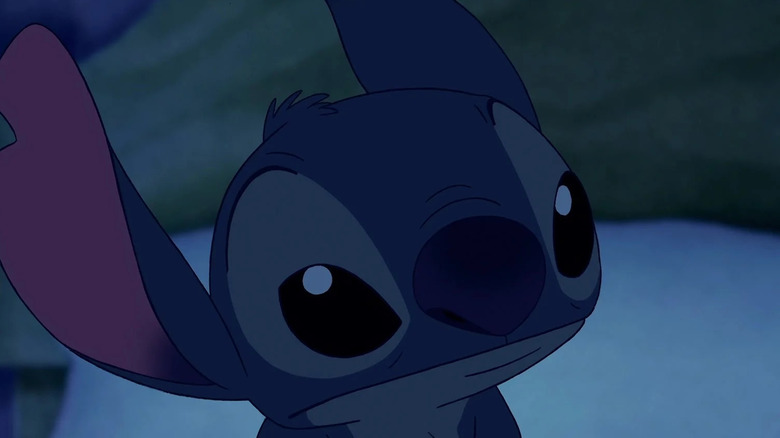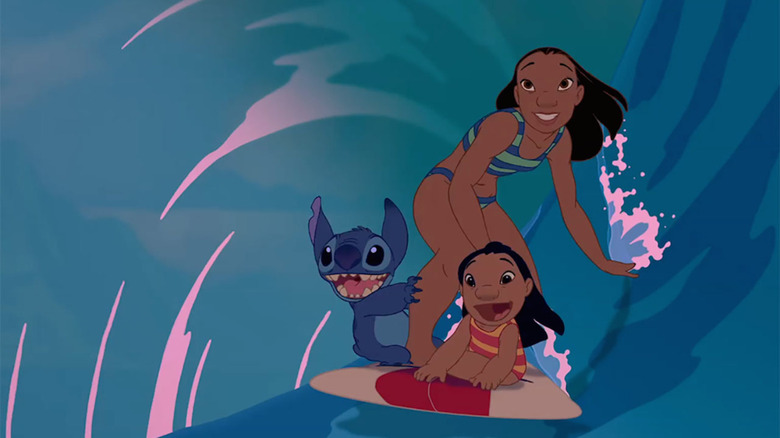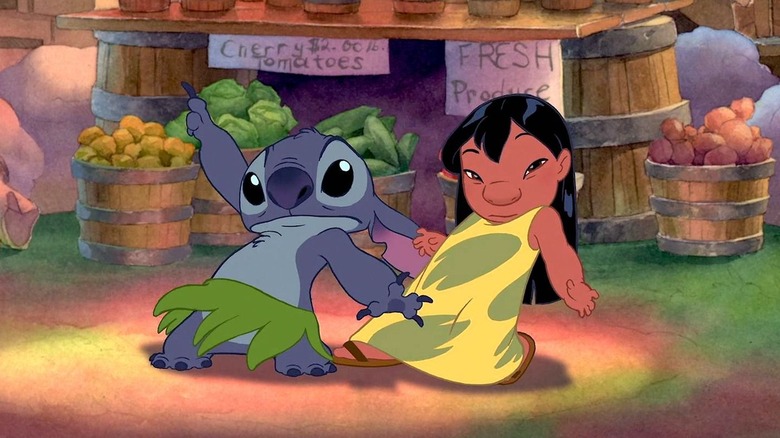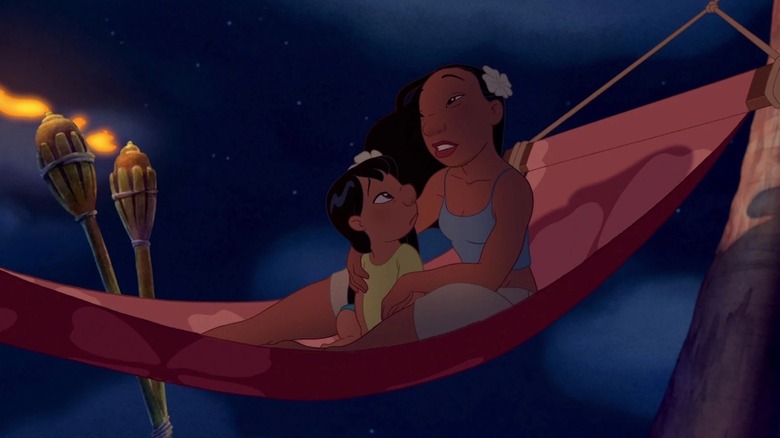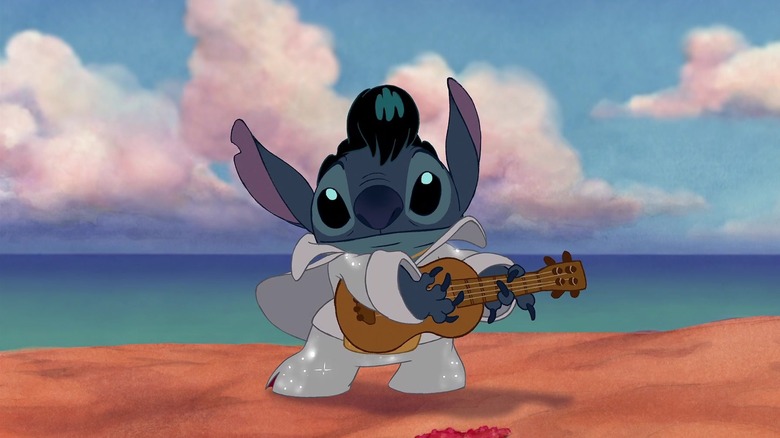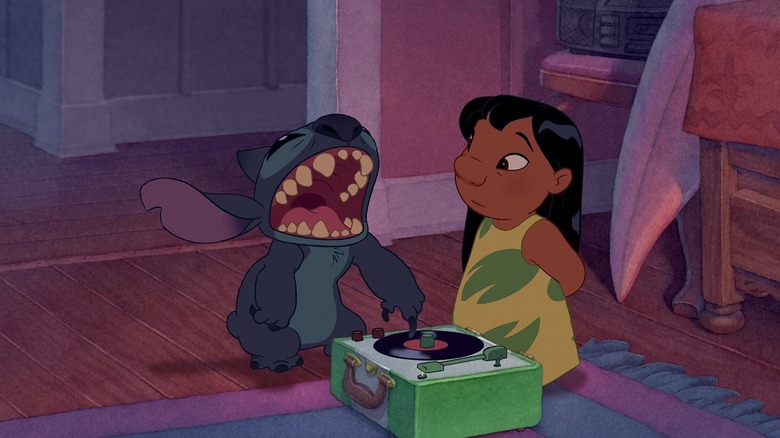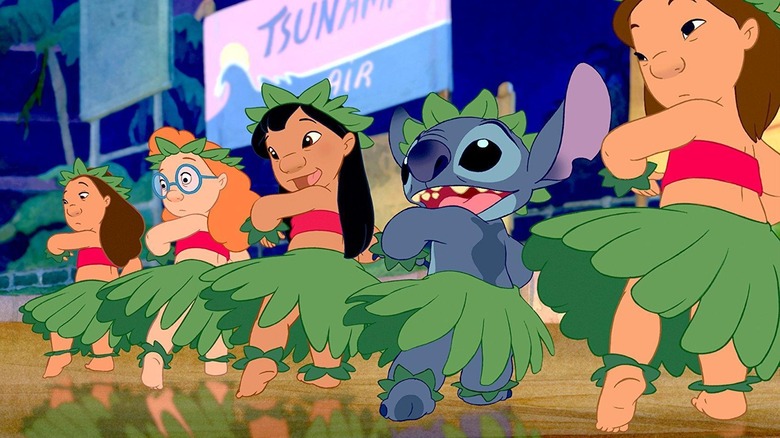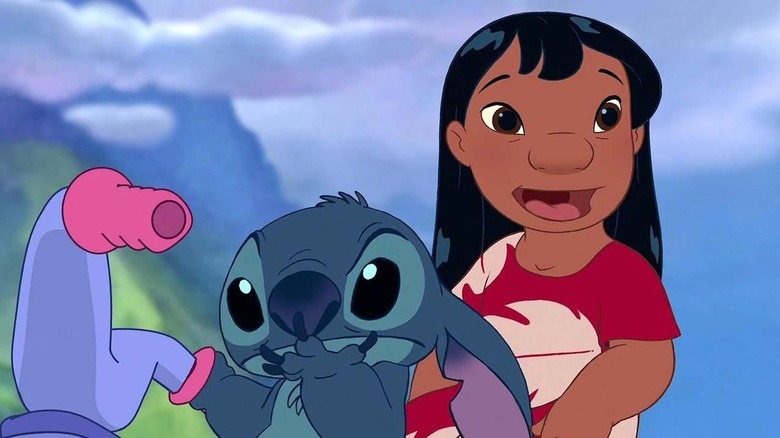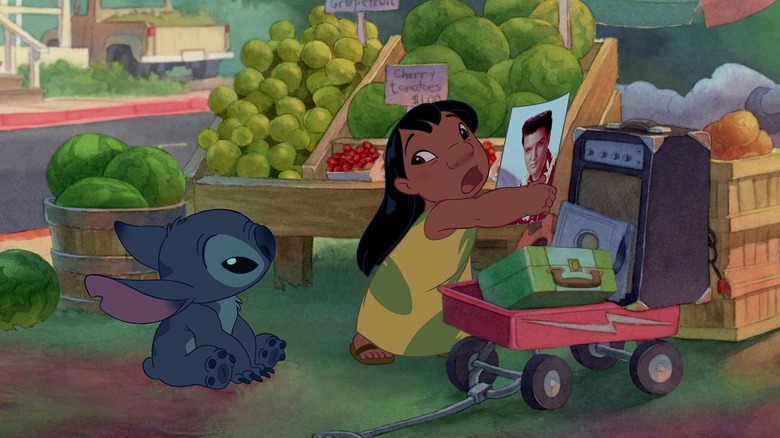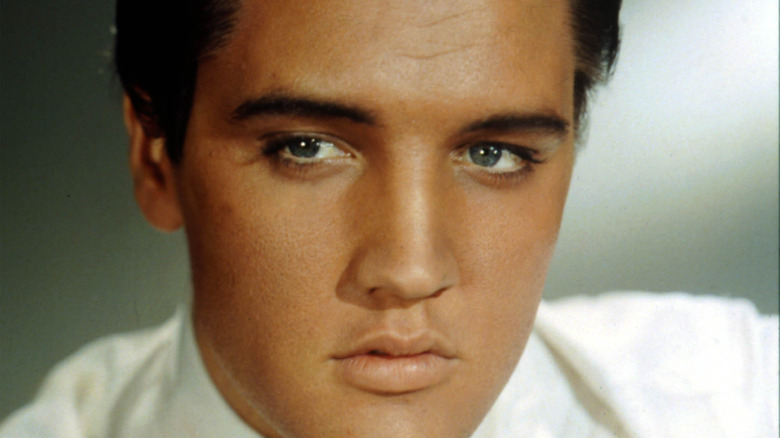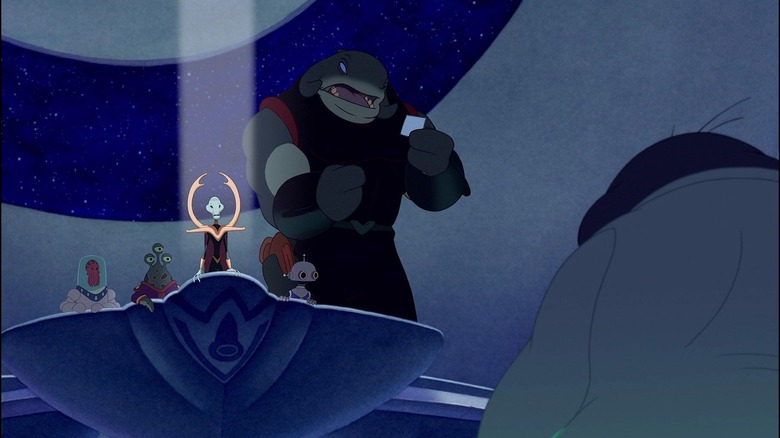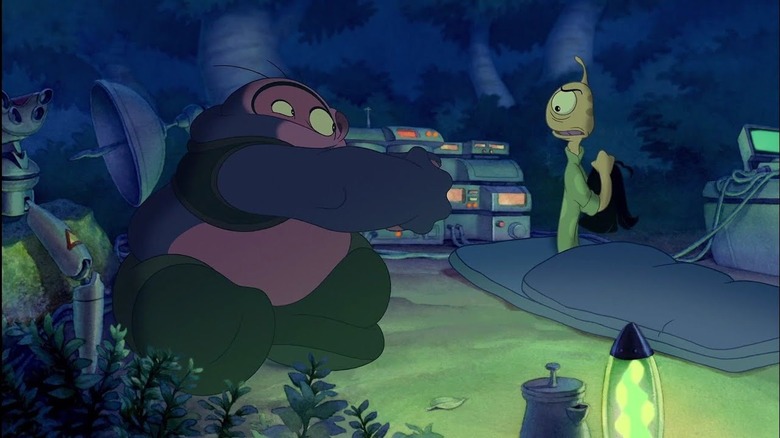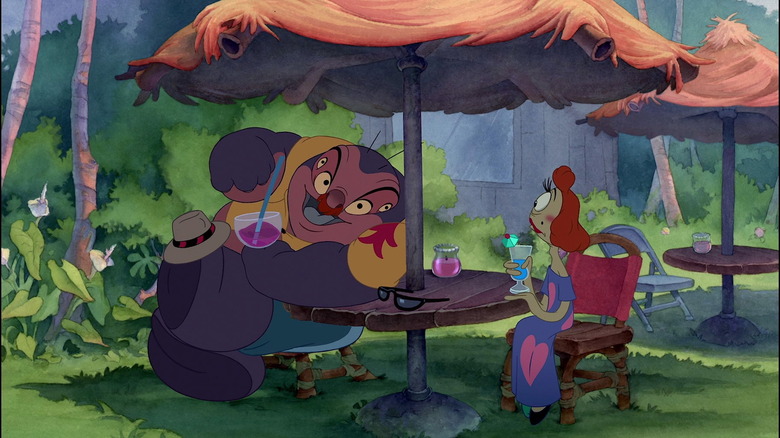The Untold Truth Of Lilo & Stitch
The early 2000s were not the best era for Walt Disney Animation Studios. After years of riding high thanks to hits like "Aladdin" and "The Lion King," this studio was stuck in a creative and box office rut (via Inverse), as seen by legendary flops like "Atlantis: The Lost Empire" and "Treasure Planet." But that doesn't mean this era of Disney Animation history was devoid of bright spots. After all, "Lilo & Stitch" was released in 2002, sparking a brand-new franchise in the process. A movie that revels in being weird and peculiar, "Lilo & Stitch" struck a chord with moviegoers thanks to its oddball humor, but also due to its surprising amount of heart. A story emphasizing the presence and importance of unorthodox families was something audiences ate up, especially when it featured a feisty alien like Stitch.
While "Lilo & Stitch" has remained enormously popular in the decades since its release, that doesn't mean every aspect of this feature has become as universally well-known as the movie's best gags. The untold truth of "Lilo & Stitch" covers a wide array of under-discussed details about this entry in the Disney Animation canon, including how this movie didn't start life as a feature at all. Grab every member of your Ohana and prepare to catch the exciting wave that is the untold truth of "Lilo & Stitch."
Lilo & Stitch started life as a children's book
Stitch is a little rambunctious ball of fire perfectly designed for hand-drawn animation, while his story of learning to embrace a "broken, but still good" family is perfectly suited for a feature-length narrative. However, co-director Chris Sanders didn't always expect to tell the saga of "Lilo & Stitch" cinematically. Instead, this filmmaker first came up with the idea for a troublemaker alien with Stitch's personality when he was coming up with children's book concepts nearly two decades before "Lilo & Stitch" dropped into theaters (per Animation World Network).
Sanders explained to AWN that in 1985 he attempted to make a children's book centered on a character who was an earlier version of Stitch. While trying to make this idea a reality, Sanders was struck by how this version of Stitch didn't work in these confines. The "character was so subtle" that he wouldn't be able to work properly within a story that only lasted "24 or 32 pages." Roughly a decade later, around 1996, Sanders was asked to pitch original ideas for movies to Walt Disney Animation Studios (via AWN). This is when he decided to revive the Stitch character, a decision that would eventually result in this alien finding a proper home in the 2002 film "Lilo & Stitch."
Lilo & Stitch was supposed to take place in Kansas
Today, it's impossible to imagine "Lilo & Stitch" taking place anywhere but Hawaii. The state, so often ignored in American pop culture, is integral to "Lilo & Stitch" in countless ways. These include the way it informs the film's unique music landscape to the way its Pacific culture molds some of the movie's most pivotal emotional moments (the word 'ohana alone!). But when "Lilo & Stitch" was coming to life for the very first time, this story of a little girl and her alien wasn't supposed to be set in Hawaii, but rather in another U.S. state: Kansas. Yes, the home of Dorothy Gale was initially set to also be the home of this rambunctious Disney tale (per Animation World Network).
Talking to IGN, co-director Dean DeBlois recalled how the original "Lilo & Stitch" would've exploited the Kansas setting by having the titular alien engage with the state's wildlife only to have these critters constantly rebuff Stitch. Once "Lilo & Stitch" was getting underway as a green-lit movie, though, the team began to consider other options for where to set the story. Co-director Chris Sanders eventually noticed how isolated the Hawaiian islands were from the rest of North America (per Polygon). This would make it the perfect place to set a story about a young girl and an alien who both feel lost and detached from everyone else. With that, the story could start falling into place.
Lilo & Stitch was meant to be an intimate departure for the studio
Throughout the 1990s, Walt Disney Animation Studios garnered a reputation for going big and grand with its features. Other Disney animated movies like "The Lion King" or "The Hunchback of Notre Dame" were expansive tales of love, adventure, heartbreak, and every emotion in between. Some of these large endeavors became untouchable classics, but if you make everything big, eventually, that scale loses its impact. That's why "Lilo & Stitch" was built from the ground up to be a departure from those earlier works. "Lilo & Stitch" may have been a sci-fi comedy, but it was also going to be a more intimate creation than many of its predecessors.
Co-director Chris Sanders recalled how the large nature of "Mulan" specifically made him yearn for a more intimate production if only to keep the animators at Disney Animation versatile and on their toes (per Animation World Network). He also noted that a much larger crew will often bog down the creative process and keep things moving at a snail's pace. As a result, "Lilo & Stitch" was made on a much lower budget and with a significantly smaller crew than other Disney Animation projects at the time (per The Wall Street Journal). As a result of that, though, "Lilo & Stitch" got the freedom to be a little bolder and more intimate in its storytelling, two qualities that would eventually define why audiences fell so hard for the feature.
The film's art style was a bit of a throwback
The backdrops of "Lilo & Stitch" are some of the most distinctive parts of the entire feature, as they're rendered as watercolor paintings. In an age when animated films were leaning more and more toward realizing everything through crisp three-dimensional CG artistry, "Lilo & Stitch" went retro by executing the Hawaii backdrops of this sci-fi comedy through a simpler old-fashioned art style (per IGN). Not only did this make "Lilo & Stitch" unique among early 2000s theatrical animated features, but it also made the project a significant one in the history of Walt Disney Animation Studio productions.
In a breakdown of the film's production (via IGN), it was noted that "Lilo & Stitch" was the first Disney Animation project in 60 years to employ watercolor backgrounds. In doing so, the film echoed Golden Age Disney films like "Bambi" (via The New York Times), a title with a drastically different tone than the ribald and irreverent "Lilo & Stitch." However, both were looking to tell stories set against nature-heavy backdrops rather than tales told in bustling modern urban locations, making their shared use of watercolor backgrounds more understandable. Through utilizing such old-school visual approaches, "Lilo & Stitch" cemented one of the most distinctive details in its acclaimed animation style.
Stitch originally didn't speak
While Stitch isn't the most varied or detailed speaker, the fact that this little guy alternates between speaking in an alien dialect and English is quite crucial for his character. After all, his increasing fluency in English is meant to serve as a reflection of how much more comfortable he's becoming with Earthlings like Lilo and Nani. His little proclamations about being "fluffy" or his final monologue about how he's found his "family" also allowed the character to engage in unique moments of levity and poignancy. Stitch's vocal chops are indeed a key part of his character, but there was a point in the production of "Lilo & Stitch" when he was planned to be a non-speaking player in his own story.
Talking to The Oklahoman, co-director and co-writer Chris Sanders revealed that the original plan for Stitch was that he would "make animal noises" rather than talk in written dialogue. However, one year into making the film, it became obvious that Stitch was going to need to speak, even if it was only for a handful of moments. This was when Sanders was called on to fill another role in the project: voice actor. Having provided a temp track for Stitch's noises in the earliest days of production (via The Oklahoman), Sanders would now be voicing Stitch's sparse instances of dialogue. Audiences would've missed out on such immediately distinctive voice work if the original plans for silent Stitch had stayed in place.
The film's low budget ended up helping it
Looking back on the making of "Lilo & Stitch" (via Polygon), directors Chris Sanders and Dean DeBlois recalled that one defining factor of the production was how cheap it was comparatively. While far from an indie movie, the $80 million price tag of "Lilo & Stitch" was significantly below the $136 million budget of "Treasure Planet" or the $110 million price tag of "Home on the Range." It was even beneath the budgets of rival animated films, like "Shrek 2," which cost nearly double "Lilo & Stitch" with a whopping $150 million cost. This did mean that "Lilo & Stitch" was entering a competitive marketplace with significantly less scale than other animated titles.
However, Sanders and DeBlois also noted that costing less had its upsides. Specifically, Disney executives were way less constantly concerned with a movie that cost just $80 million to make. Without having to deal with as many studio notes as average Walt Disney Animation Studios titles, the filmmakers had the freedom to actually try new and exciting things when it came to "Lilo & Stitch" (via Polygon). Even better, they could employ old-school hand-drawn animation techniques for the entire film rather than lean so heavily on CG enhancements (via Polygon). Though it went out cheaper than most Disney Animation features, "Lilo & Stitch" was still able to come out looking like a million bucks.
Lilo & Stitch's ending was impacted by 9/11
"Lilo & Stitch" ended with the titular alien flying an aerial vehicle to chase down the alien Gantu after he kidnapped Lilo. It always worked as a reflection of how much Stitch had grown as a character, with this extraterrestrial now putting his life on the line for his Earthbound pal. However, during production, the original vision for this chase sequence was changed drastically. Initially, Stitch would've engaged in this chase by stealing a 747 jet airplane and chasing Gantu across a city, with the plane rubbing against buildings and causing mayhem (per The Entertainment Nut).
Directors Chris Sanders and Dean DeBlois recounted this ending and noted that there didn't seem to be a problem with it until the terrorist attacks of September 11, 2001 (via Polygon). In the wake of the attacks on the World Trade Center, there was no way a family-friendly Disney cartoon could end with the hero stealing an airplane and cruising across a city. A new climax would need to be arranged. The scene was kept, but reanimated so Stitch chases Gantu in the spaceship that Jumba and Pleakley used to come to Earth, which was basically plastered on top of the existing 747 model. Lengthy sequences depicting Stitch's aircraft bouncing around a city were also reanimated to take place in Hawaiian canyons (per The Entertainment Nut). With this, the finale of "Lilo & Stitch" was salvaged despite real-life tragedy.
The writers liked Lilo and Nani's messy relationship
Part of what endeared "Lilo & Stitch" so much to general audiences is how it was unflinching in its portrayal of complicated domestic life for the characters of Lilo and Nani. These two sisters, with the latter sibling now taking on a parental role, often have a strained dynamic. They yell at each other, get frustrated, but are also capable of reuniting stronger than ever. They're complicated people, much like real-life members of an unconventional family. Sequences depicting the duo's realistically nuanced rapport weren't always easy to write, but they were among the crew's favorite to bring to life (per Animation World Network).
Co-director Chris Sanders noted that "it was so freeing" to do sequences depicting such a raw and complicated relationship (per AWN). He noted that this was in contrast to a Walt Disney Animation Studios film he'd worked on previously, "Mulan," which intentionally featured a "rigid" familial unit that didn't yell at each other or get messy about emotions (per AWN). What worked for "Mulan" wasn't going to work for "Lilo & Stitch," which instead relied on Lilo and Nani struggling to communicate and then finding ways to convey apologies to one another. Being able to grapple with nuanced instances of communication endeared these scenes to the creative team behind "Lilo & Stitch" and ended up making them favorites for moviegoers as well.
Elvis Presley's tunes almost weren't in the movie
As if "Lilo & Stitch," with its juxtaposition of wacky aliens with everyday humans and its strange sense of humor, wasn't already odd enough, the film also features several tunes from the one and only Elvis Presley. These aren't just background numbers either. The character of Lilo is fascinated with Presley and his tunes, while these songs are used to help introduce Stitch to the world of humans. The end credits of "Lilo & Stitch" even feature Wynnona Judd doing a lively cover of "Burnin' Love." From beginning to end, the spirit of Presley is heavily influencing the world of "Lilo & Stitch."
Co-director Chris Sanders revealed that Lilo's affection for Presley tunes was always a part of the "Lilo & Stitch" story, but it looked like, at one time, this wouldn't make it into the final cut of the feature (per The Oklahoman). The low-budget nature of "Lilo & Stitch" originally made it seem impossible for the film to secure the Elvis tracks it would need. However, Graceland ended up enjoying "Lilo & Stitch" so much that the crew was able to utilize several Elvis tunes and even employ a real picture of The King himself (via The Oklahoman). Through winning over Graceland, "Lilo & Stitch" was able to secure one of the most distinctive aspects of its rollicking atmosphere.
Stitch's story was subversive within the Disney Animations canon
"Lilo & Stitch" mastermind Chris Sanders had worked at Walt Disney Animation Studios for years before he to a chance to direct this 2002 sci-fi film. During that time, he learned countless valuable lessons about how to put together an animated feature, but he also grew cognizant of trends within the studio's output. Sanders noted that this included what kind of families got represented in traditional Disney Animation features (via Animated Views). The stereotypical nuclear family (usually down one parent) was dominant in these works, so Sanders set out to make a film that was about families of all shapes and sizes (via Animated Views).
Additionally, Sanders also observed how classic fairy tales, the stories Disney Animation's history is built upon, often are about destroying an evil villain. With "Lilo & Stitch," Sanders set out to make a movie where the protagonist was the baddie (via Animated Views). Here, though, the adversary would not be thrown off a cliff, but rather get a chance at redemption, to demonstrate that they can do something good. With this deviation, Sanders wanted to convey to the audience that people are complicated creatures who are capable of greatness even when they make mistakes (per Animated Views).
Lilo & Stitch was a surprise hit
After the 1990s brought a deluge of positive box office developments for Walt Disney Animation Studios, the 2000s were a much rougher time for the outfit. Struggling against competition with companies like Pixar Animation Studios (per The Los Angeles Times) and DreamWorks Animation (per Polygon), Disney Animation was also flanked by major box office flops like "Atlantis: The Lost Empire" and "Treasure Planet." But in the middle of all this financial turmoil came an unexpected hit in the form of "Lilo & Stitch." Though not as big or costly as other Disney Animation titles from the same era (via Polygon), it still outperformed earlier Disney animated films.
Grossing $145.7 million in North America alone, "Lilo & Stitch" left the likes of "Atlantis" and "Treasure Planet" in the dust and even managed to surpass 1990s heavyweights like "Pocahontas" and "Beauty and the Beast" in this territory. Grossing another $100 million overseas, "Lilo & Stitch" amassed $245.7 million worldwide, a rock-solid haul given its $80 million budget. Even better, it was just the kind of gross Disney Animation needed at this moment in time. In an era where it looked uncertain if there was any future for Disney Animation in the theatrical landscape, "Lilo & Stitch" came out of nowhere to reaffirm the financial viability of the company.
Co-director Chris Sanders is nervous about a live-action remake
The trend of Disney remaking classic animated movies into live-action titles has spread far and wide across the studio's library. However, up to this point, it's exclusively involved titles released during the 20th century. This ranges wildly from 1941's "Dumbo" to 1998's "Mulan," but Disney has largely avoided even talking about remaking 21st century Walt Disney Animation Studios titles such as "The Emperor's New Groove." A gigantic exception to this was the announcement that a live-action remake of "Lilo & Stitch" was in development (per Variety). Once set to be helmed by Jon M. Chu (per The Hollywood Reporter), the existence of such a production speaks to the enduring popularity of "Lilo & Stitch."
Co-director Chris Sanders expressed nervousness about this remake primarily because it would be live-action (via CinemaBlend). As Sanders put it, the stylized hand-drawn world of "Lilo & Stitch" made it much more believable that Hawaiian citizens would just accept that a blue furry alien was actually a dog. Rendered in live-action, complete with realistic CG effects, Sanders felt that something would get lost here, that the story of "Lilo & Stitch" would just not work as well when grounded in flesh-and-blood reality (via CinemaBlend). While not dismissing the project entirely, Sanders did have understandable concerns about translating a story so perfectly suited to animation into another medium.
